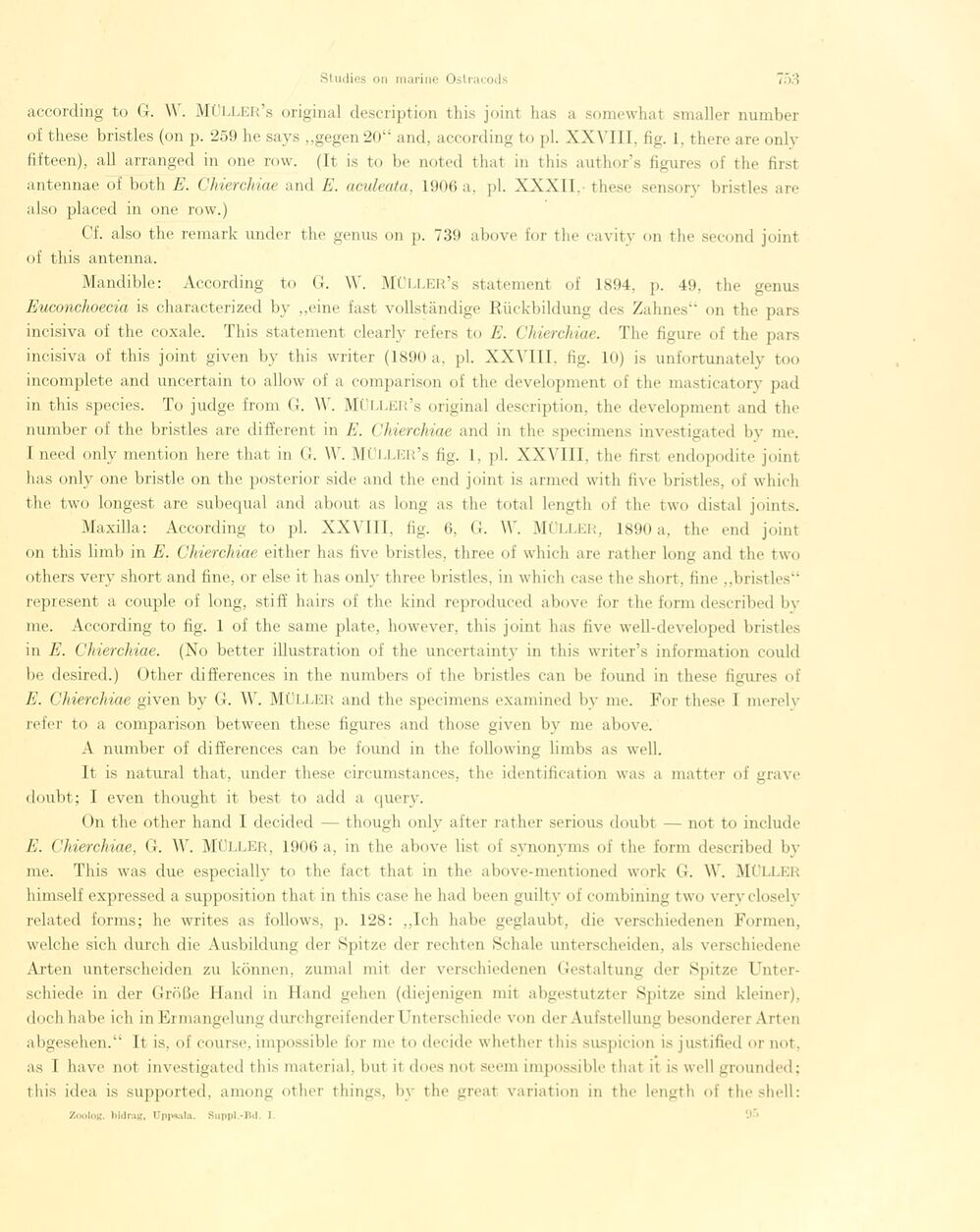
Full resolution (JPEG) - On this page / på denna sida - Sidor ...

<< prev. page << föreg. sida << >> nästa sida >> next page >>
Below is the raw OCR text
from the above scanned image.
Do you see an error? Proofread the page now!
Här nedan syns maskintolkade texten från faksimilbilden ovan.
Ser du något fel? Korrekturläs sidan nu!
This page has never been proofread. / Denna sida har aldrig korrekturlästs.
according to G. W. MüLLER’s original description this joint has a somewhat smaller number
of tliese bristles (on p. 259 he says „gegen 20“ and, according to pi. XXYI1I. fîg. 1. there are only
fifteen), all arranged in one row. (It is to be noted that in this author’s figures of the first
antennae of both E. Chierchiae and E. aculeata, 1906 a, pl. XXXII. these sensor)7 bristles are
also placed in one row.)
Cf. also the remark under the genus on p. 739 above for the cavity on the second joint
of this antenna.
Mandible: According to G. \Y. MüLLER’s statement of 1894, p. 49, the genus
Euconchoecia is characterized by „eine fast vollständige Rückbildung des Zahnes“ on the pars
incisiva of the coxale. This statement clearly refers to E. Chierchiae. The figure of the pars
incisiva of this joint given by this writer (1890 a, pl. XXVIII, fig. 10) is unfortunately too
incomplete and uncertain to allow of a comparison of the development of the masticatory pad
in this species. To judge from G. \V. MüLLER’s original description, the development and the
number of the bristles are different in E. Chierchiae and in the specimens investigated bv me.
I need only mention here that in G. \Y. MÜl.LER’s fig. 1, pl. XXVIII, the first endopodite joint
has only one bristle on the posterior side and the end joint is armed witli five bristles, of whicli
the two longest are subequal and about as long as the total length of the two distal joints.
Maxilla: According to pi. XXVIII, fig. 6, G. \Y. Müller, 1890 a, the end joint
on this limb in E. Chierchiae either has five bristles, three of whieh are rather long and the two
others very short and fine, or else it has only three bristles, in which case the short, fine „bristles“
represent a couple of long, stifï hairs of the kind reproduced above for the form described bv
me. According to fig. 1 of the same plate, however, this joint has five well-developed bristles
in E. Chierchiae. (No better illustration of the uncertainty in this writer’s information could
be desired.) Other differences in the numbers of the bristles can be found in these figures of
E. Chierchiae given by G. AV. Müller and the specimens examined by me. For these I merely
reier to a comparison between these figures and those given by me above.
A number of differences can be found in the following limbs as well.
It is natural that, under these circumstances, the identification was a matter of grave
doubt; I even thought it best to add a query.
On the other hånd I decided — though only after rather serious doubt — not to include
E. Chierchiae, G. AV. MÜLLER, 1906 a, in the above list of synonyms of the form described by
me. This was due especially to the faet that in the above-mentioned work G. AA’. MÜLLER
himself expressed a supposition that in this case he had been guilty of eombining two very closely
related forms; he writes as follows, p. 128: „Ich habe geglaubt, die verschiedenen Formen,
welche sich durch die Ausbildung der Spitze der rechten Schale unterscheiden, als verschiedene
Arten unterscheiden zu können, zumal mit der verschiedenen Gestaltung der Spitze
Unterschiede in der Größe Hand in Hand gehen (diejenigen mit abgestutzter Spitze sind kleiner),
doch habe ich in Ermangelung durchgreifender Unterschiede von der Aufstellung besonderer Arten
abgesehen.“ It is, of course, impossible for me to decide whether this suspicion is justified or not,
as 1 have not investigated this material, but it does not seem impossible that it is well grounded;
this idea is supported, among other things, by the great variation in the length of theshell:
Zoolog, bidrag, Uppsala. Suppl.-Bd. I.
<< prev. page << föreg. sida << >> nästa sida >> next page >>